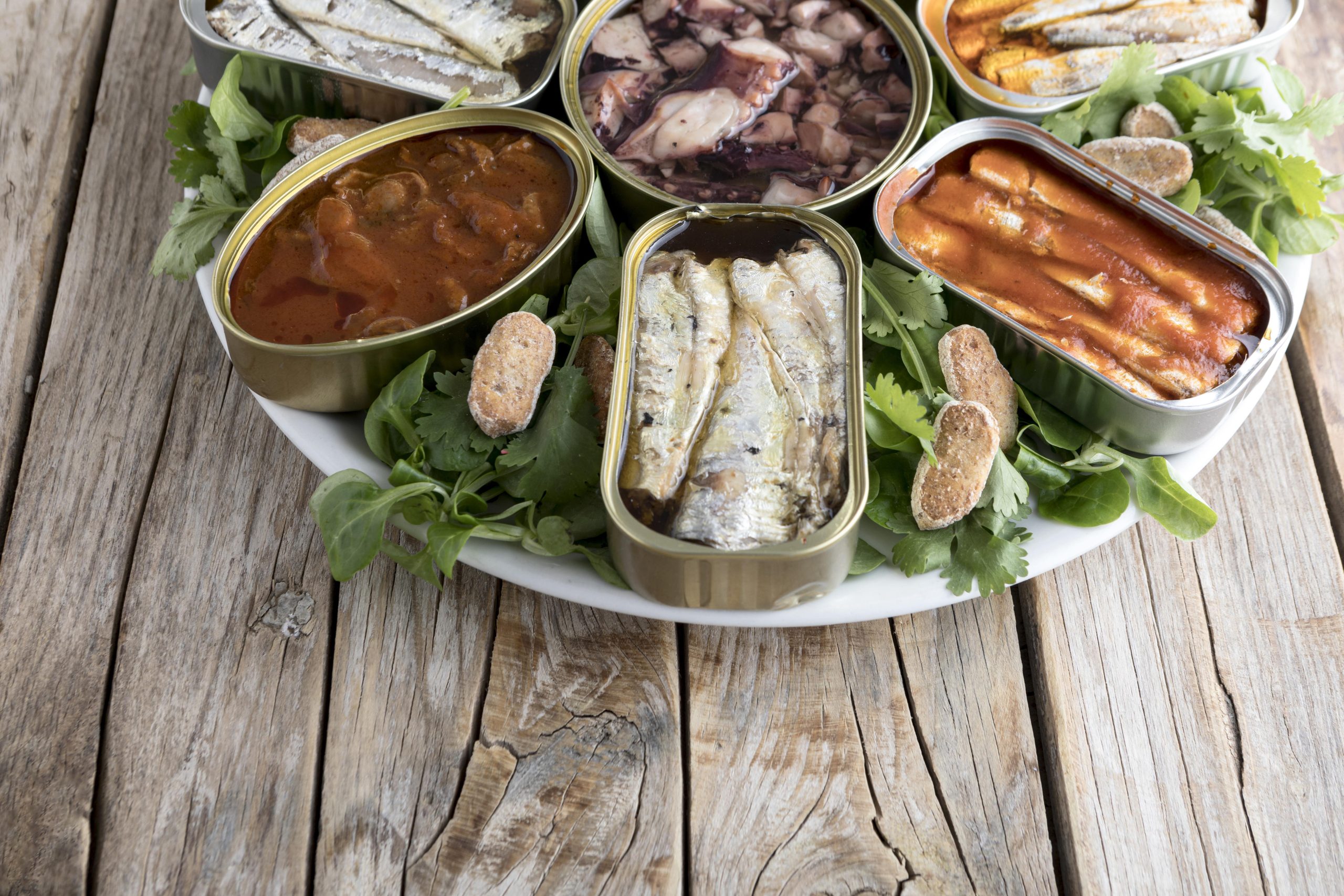Well, wonder no more. We have all the answers you need to make an informed decision. From the health benefits and potential risks of consuming tinned fish to tips on selecting high-quality options and delicious recipes to try, this discussion will provide you with the guidance you’re looking for. So, if you’re curious about how many times a week you should be enjoying tinned fish, keep reading to find out!
Health Benefits of Tinned Fish
Eating tinned fish can provide numerous health benefits due to its rich content of essential nutrients and omega-3 fatty acids. Tinned fish, such as sardines, tuna, and salmon, are packed with essential vitamins and minerals that are crucial for a balanced diet. They are particularly high in omega-3 fatty acids, which have been linked to various health benefits. Omega-3 fatty acids are known to support heart health by reducing inflammation and lowering triglyceride levels. They also play a crucial role in brain function and have been associated with improved cognitive function and reduced risk of neurodegenerative diseases. Incorporating tinned fish into your diet can be an excellent way to reap the benefits of omega-3 fatty acids without the expense of fresh seafood options. However, it is essential to consume tinned fish in moderation, as excessive intake may lead to health implications such as high sodium intake. Overall, adding tinned fish to your diet can be a convenient and affordable way to enhance your nutritional intake and enjoy the health benefits of omega-3 fatty acids.
Types of Tinned Fish to Choose From
When choosing tinned fish, it’s important to consider the different types available to ensure you’re getting the desired nutritional benefits. There are several options to choose from, each with its own unique qualities. One popular choice is canned tuna, which is high in protein and a good source of omega-3 fatty acids. Canned salmon is another excellent option, as it is also rich in omega-3s and low in saturated fat. If you’re looking for a fish with a bolder flavor, canned mackerel and sardines are high in omega-3s and provide essential nutrients for a balanced diet.
When it comes to sustainability, it’s important to choose tinned fish that is sourced responsibly. Look for brands that prioritize sustainable fishing practices and are transparent about their sourcing methods. This ensures that you’re making an environmentally conscious choice while still enjoying the nutritional benefits of tinned fish.
In terms of cooking techniques, tinned fish is already cooked and prepared, making it a convenient option. You can enjoy it straight from the can as a quick and healthy snack, or incorporate it into various dishes like salads, pasta, and sandwiches.
When comparing tinned fish brands, consider factors such as taste, quality, and price. Explore different brands and flavors to find the one that suits your preferences. Reading reviews and checking the nutritional information on the packaging can also help you make an informed decision.
Frequency of Tinned Fish Consumption
To maintain a balanced and healthy diet, it is important to consider the frequency of consuming tinned fish. While tinned fish can be a convenient and affordable option, it is also essential to explore alternatives to ensure a diverse intake of nutrients. Cooking methods for tinned fish can vary, including options such as grilling, baking, or incorporating it into salads and sandwiches. Tinned fish, such as tuna or sardines, can be a good source of essential nutrients like omega-3 fatty acids, protein, and minerals. However, it is crucial to be mindful of the sustainability of tinned fish. Choosing sustainably sourced options helps preserve marine ecosystems and supports responsible fishing practices. In a balanced diet, tinned fish can be included as part of a varied and nutritious meal plan. However, moderation is key, and it is recommended to consume tinned fish no more than two times a week, while also incorporating other sources of protein and essential nutrients into your diet. By considering these factors, you can enjoy the benefits of tinned fish while maintaining a healthy and sustainable eating pattern.
Potential Health Risks of Eating Tinned Fish
Are there any potential health risks associated with consuming tinned fish? While tinned fish can be a convenient and nutritious option, it is important to be aware of the potential health risks, particularly related to its sodium content. Tinned fish often contains high levels of sodium, which can have a negative impact on blood pressure and increase the risk of heart disease, stroke, and other cardiovascular issues. To provide a clearer understanding, here is a table showcasing the sodium content in different types of tinned fish:
| Type of Tinned Fish | Sodium Content |
|---|---|
| Tuna | High |
| Salmon | Moderate |
| Mackerel | High |
| Sardines | Moderate |
To mitigate the risks of high sodium intake, it is advisable to consider alternatives to tinned fish, such as fresh or frozen fish. Additionally, when using tinned fish in recipes, there are strategies for reducing sodium, such as rinsing the fish before use or opting for low-sodium varieties. Being mindful of sodium intake and incorporating a balanced diet with fresh vegetables, fruits, and other nutrient-rich foods can help promote overall health and well-being.
Balancing Tinned Fish With Fresh Seafood
Balancing tinned fish with fresh seafood can provide a diverse range of nutritional benefits for a well-rounded diet. Here are four reasons why incorporating variety into your seafood choices can maximize health benefits:
- Nutritional value comparison: While canned fish, such as tuna and salmon, offer convenience and are high in protein and omega-3 fatty acids, fresh seafood alternatives like herring, mackerel, and trout provide similar nutritional benefits. Fresh seafood also tends to have a higher vitamin and mineral content compared to canned options.
- Maximizing health benefits: By including both tinned fish and fresh seafood in your diet, you can ensure a more comprehensive intake of essential nutrients. Fresh seafood, with its wider variety of species, offers a broader range of vitamins, minerals, and antioxidants that contribute to optimal health.
- Potential drawbacks: Canned fish may contain higher levels of sodium compared to fresh seafood. Additionally, the canning process may lead to a slight loss of certain nutrients. By incorporating fresh seafood alternatives, you can mitigate these potential drawbacks and enhance the overall nutritional value of your meals.
- Incorporating variety: Variety is key when it comes to a healthy diet. By alternating between tinned fish and fresh seafood, you can enjoy different flavors and textures while reaping the benefits of a diverse range of nutrients. Plus, it adds excitement and versatility to your meals.
Delicious Recipes Using Tinned Fish
Looking to add some variety to your meals? Try these delicious recipes using tinned fish. Not only are these recipes tasty, but they also provide nutritional benefits. Tinned fish, such as tuna, salmon, mackerel, and sardines, are rich in omega-3 fatty acids, which are essential for heart and brain health. They are also a good source of lean protein and minerals. When choosing tinned fish, opt for sustainable options to support environmental conservation.
Here are a few meal ideas to incorporate tinned fish into your diet:
- Tuna Pasta Salad: Mix canned tuna with cooked pasta, cherry tomatoes, cucumber, and a light dressing. This refreshing salad is perfect for a quick and easy lunch.
- Salmon and Avocado Toast: Spread mashed avocado on whole-grain toast and top with canned salmon. Add a squeeze of lemon juice and some fresh herbs for extra flavor.
- Mackerel and Quinoa Bowl: Combine cooked quinoa with canned mackerel, roasted vegetables, and a drizzle of olive oil. This hearty bowl is packed with omega-3s and fiber.
- Sardine Stuffed Peppers: Stuff bell peppers with a mixture of canned sardines, breadcrumbs, and herbs. Bake until the peppers are tender and the filling is golden brown.
These recipes offer a delicious way to enjoy the nutritional benefits of tinned fish while adding variety to your meals. Remember to check the sodium content of your chosen tinned fish and limit your intake to maintain a healthy sodium balance.
Tips for Selecting High-Quality Tinned Fish
To ensure you are selecting high-quality tinned fish, it is important to consider a few key factors:
- Sustainable Sourcing: Look for tinned fish that is sourced sustainably. This means the fish is caught using methods that minimize harm to the environment and maintain healthy fish populations.
- Nutritional Content: Check the nutritional information on the packaging to understand the content of the tinned fish. Look for options that are high in omega-3 fatty acids, low in saturated fat, and provide essential nutrients for a balanced diet.
- Flavor Options: Explore different brands and flavors to find your preferred choice. Some tinned fish may be packed in oil, water, or tomato sauce, which can affect the taste and texture. Choose the flavor option that suits your taste preferences and dietary needs.
- Packaging Information: Pay attention to the packaging information to ensure the tinned fish is properly preserved. Check for any signs of damage or bulging cans, as this may indicate spoilage. Additionally, consider the size of the cans and whether they are suitable for your intended use.
Contact Information and Inquiries
For any further information or inquiries, please reach out to Erican Enterprise Ltd. at the following contact details: [email protected] or +86 312 3288 268 / +86 188 3125 5553.
When it comes to the availability of canned fish online, it is important to consider the benefits of sustainable fishing. Sustainable fishing practices ensure the long-term health of fish populations and the marine environment. Canned fish offers a convenient and affordable way to enjoy the nutritional benefits of fish, but how does it compare to fresh fish?
While fresh fish is often praised for its superior taste and texture, canned fish can be just as nutritious. The canning process preserves the nutritional value of fish, including its protein content and omega-3 fatty acids. In fact, canned fish like tuna, salmon, mackerel, and sardines are all excellent sources of omega-3 fatty acids.
When it comes to storing canned fish, it is important to keep them in a cool, dry place. Once opened, transfer any leftovers to an airtight container and refrigerate them. Canned fish can typically be stored for 3 to 5 years, but always check the expiration date before consuming.
If you’re looking to compare different brands of canned fish, consider factors such as the type of fish used, the sustainability of their sourcing, and any added ingredients or preservatives. Reading reviews and conducting research can help you choose a brand that meets your preferences and dietary needs.


